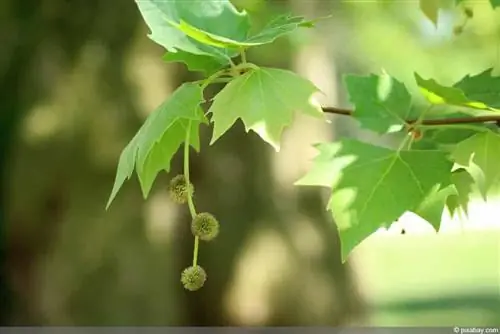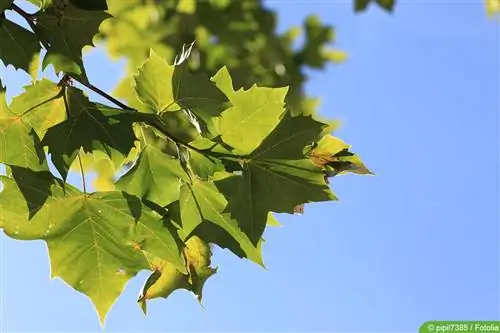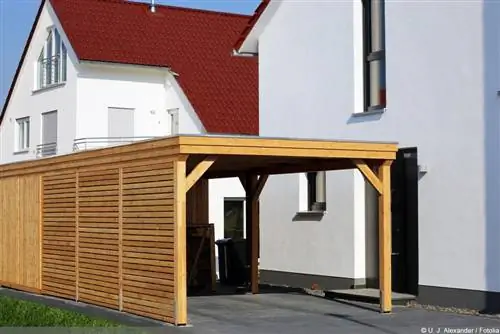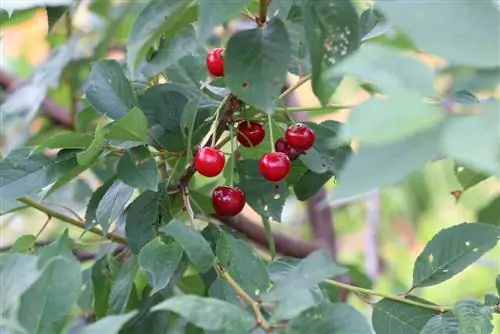- Author admin [email protected].
- Public 2023-12-17 03:39.
- Last modified 2025-01-24 12:45.
The roof plane tree is a very unusual plant in terms of its appearance. It forms a treetop in the shape of a roof, which makes it look very interesting. Because the plant is also relatively easy to care for, it is worth purchasing this special plant for your own garden because it is a great natural source of shade.
Location
The overall lush and fast-growing plant needs a location that takes its rapid further development into account. It is important that there is enough free space around the roof plane tree and that you also consider that it will quickly rise many meters in height and that an optimal location must also be provided here. A spacious open space is optimal for the roof plane tree to unfold. Due to the rapid and immense growth of roof plane trees, you should avoid planting them in front gardens or small ornamental gardens. Regardless of this, the roof plane tree needs a location in full sun, but it also easily accepts light partial shade. Since the tree has deep roots, the soil should be humus-rich and deep. When choosing a location, you should also pay attention to pipes and underground cables, because the roof plane tree dominates its location and may also destroy cables and pipes through root growth. Due to its resistance to strong air pollution, the roof plane tree can also be easily planted in inner-city areas with high air pollution.
The optimal location:
- Not a front garden or ornamental garden plant due to its intensive growth
- full sun or light partial shade as a location
- intensive deep rooting can damage pipes and cables
Plants
If there is optimal space in your own garden, then the plane tree can also be planted there. It is important that planting always takes place in the warmer phase of spring so that the plant still has enough time to take root in the new location before it begins to grow strongly. It is important that the planting hole is sufficient for the home-grown or purchased plant. As a rule, the planting hole must be three times the depth and width of the root ball size. First, the soil is loosened before planting and then, before the excavated soil is filled again, it is loosened with compost and pebbles. Mixing the soil with these two substances not only improves the nutrient supply to the roots, but also causes the pebbles to loosen the soil permanently.
It is important that the root edge of the plane tree is completely covered with plant substrate and that the soil is pressed firmly around the plant after the plant has been inserted. Afterwards, abundant watering must be carried out immediately, because in the first few weeks young plants do not yet have the potential to independently and adequately supply themselves with water from the surrounding soil. Therefore, sufficient watering with low-lime water is necessary, especially in the first few weeks after planting.
Substrate and soil
The best base for the roof plane tree is sandy to loamy soil. These should be neutral to an alkaline pH value. It is particularly important for young plants to have fresh soil that is particularly nutrient-rich and thus promotes good development. Because the roots grow relatively deep into the soil, deep soil is a requirement.
The optimal soil:
- sandy to loamy
- neutral to alkaline
Fertilize
Compost should be incorporated into the substrate every spring or late summer. Otherwise, adult plants are very modest when it comes to nutrient supply, because they absorb the nutrients and liquid they need from deep in the soil. However, incorporating compost in the first few years greatly supports the growth and stability of the plant. Slow-release fertilizers or similar fertilizers do not need to be used.
Pouring
The young plant needs sufficient watering with lime-free water in the first two to three years outdoors, especially in the hot summer months. The substrate for young plants should always be kept moist, but it is important to avoid waterlogging. Optimum watering is supported by a watering edge, which consists of a raised area in the ground from which the plant protrudes. The area should be kept free of weeds and mulched regularly so that the irrigation water can always penetrate the soil immediately and unhindered.
Cutting
The plant grows very luxuriantly, is therefore particularly resistant to cutting and does not make any beginner's mistakes when cutting. Dead and diseased branches can be cut out all year round. However, the thinning and training cuts should stick to fixed seasons. Basically, at the beginning of summer, the lower side branches are trimmed relatively close to the trunk without damaging the branch collar. Main shoots must under no circumstances be included in the cut, otherwise the crown structure, the characteristic of this tree, will be destroyed.
A thinning cut is best carried out during the plant's vegetation break, which lasts from October to February. During this time, poorly growing and disruptive branches can be cut off so that shoots do not interfere with each other's growth. It is important for this cut to have sharp tools that are also disinfected before and after work. In this way, the transmission of diseases to or from other garden plants can be avoided. If clean and smooth cuts are achieved, there is no need to close the wound.
Wintering
The roof plane tree is considered hardy and robust. Only young plants need to be protected from frost in the first two years with a protective layer of brushwood, bark mulch or compost. These protective materials, which decompose in the long term, also ensure the young plant's nutrient supply in the following spring. You should know that this plant not only sheds its leaves in autumn, as is usual with domestic deciduous trees, but that it also separates a large part of its bark in autumn. This gives the plant a somewhat skeleton-like appearance in the winter months.
Tip:
Fallen leaves and bark should not be disposed of in your own compost as the rotting process is very lengthy.
Diseases/Pests
The fast-growing and robust trees are often attacked by aggressive fungal pathogens, which cause leaves and branches to die. The so-called Apiognomonia veneta can be recognized by uneven jagged discolorations within the blood veins and on the long sides of the main vein of the leaves. This fungus causes the leaves of the plane tree to fall early. It is important to consistently remove all affected shoots and leaves in order to contain the disease. Fungicides from garden shops and regular watering of the plant with a decoction of field horsetail will help the tree get back on its feet.
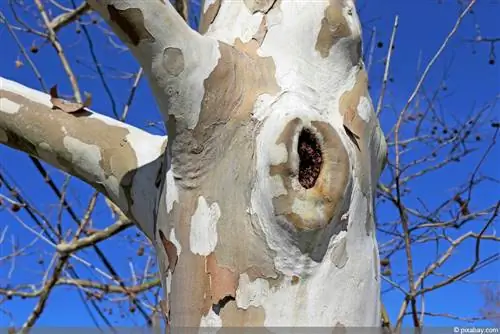
If predominantly older plane tree branches fall off, Splanchnonema platani, also known as massaria disease, is usually to blame. This fungus has only been widespread in Germany for a few years and predominantly affects older trees. It is important to regularly check the tree and consistently remove pink and black branches. Removed tree parts should not end up in the compost to avoid the spread of the fungus. Unfortunately, there are no effective or preventative remedies available commercially against this fungal infestation. However, consistent removal of infected parts of the tree prevents the death of the plant.
Frequently asked questions
How does the special shape of the treetop of the roof plane tree actually come about?
The special shape of the crown is achieved using inserted bamboo sticks in the tree nursery. To create a symmetrical image, the bars are placed in the middle and securely wedged into the crown. Then it takes a few years of patience until a stable roof-like crown develops.
What else should I know when planting the roof plane tree?
The rapid and immense growth of the plant is often underestimated when it is planted in gardens. You should definitely consider this before deciding on the roof plane tree and its location.
What you should know about the roof plane tree in brief
- Roof plane trees have relatively high crown bases and therefore they take up very little space as the entire tree crown shifts upwards.
- It has green leaves similar to those of the maple tree. In autumn these change color to an enchanting ocher yellow.
- The flowers are inconspicuous and yellow to green.
- Roof plane trees are insensitive to frost and are planted either as solitary trees or in groups.
- Whether the tree crown grows flat and roof-shaped or spherical depends primarily on the cut.
- The plane trees that can be trimmed to a roof shape include the Platanus acerifola (common umbrella plane) and the ball plane.
Plants
- Most plants that are sold bare-root in stores in spring or autumn are young plants.
- Therefore you should plant them below the first eye. The planting depth is best 30 to 40 cm.
- The young plants should then be kept well moist after planting.
- Roof plane trees are fast-growing: they grow up to 50 cm per year.
Care
- The right location is in full sun, alternatively very bright.
- It is sensitive to waterlogging, so the soil should be well drained.
- The demands on the soil are low: normal or nutrient-rich, slightly acidic, alkaline or even neutral, everything is ideal for it to thrive.
Diseases
- If the plane tree has been cut, it should be treated with wound wax to prevent pest infestation at the cut wounds.
- The plane tree is actually very robust, but it could get various diseases: some fungal diseases are dangerous, for example.
- The best way to prevent this is to only prune the plant in dry weather and then treat the cut areas as mentioned above.
Cutting
- Plane trees should best be cut in winter or spring, before they sprout.
- At the same time, last year's shoots should be tied down here.
- The easiest way to do this is to use so-called bamboo or Tonkin sticks. You should tie these together to form a framework within the treetop.
- You then attach the bent shoots to this or weave them in, evenly distributed in all directions.
- All shoots that appear are also accommodated in this way. Coconut yarn is recommended for tying.

